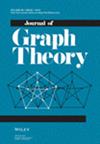求助PDF
{"title":"双方格多图中最大匹配数的锐下限","authors":"Alexandr V. Kostochka, Douglas B. West, Zimu Xiang","doi":"10.1002/jgt.23080","DOIUrl":null,"url":null,"abstract":"<p>We study the minimum number of maximum matchings in a bipartite multigraph <span></span><math>\n <semantics>\n <mrow>\n <mi>G</mi>\n </mrow>\n <annotation> $G$</annotation>\n </semantics></math> with parts <span></span><math>\n <semantics>\n <mrow>\n <mi>X</mi>\n </mrow>\n <annotation> $X$</annotation>\n </semantics></math> and <span></span><math>\n <semantics>\n <mrow>\n <mi>Y</mi>\n </mrow>\n <annotation> $Y$</annotation>\n </semantics></math> under various conditions, refining the well-known lower bound due to M. Hall. When <span></span><math>\n <semantics>\n <mrow>\n <mo>∣</mo>\n <mi>X</mi>\n <mo>∣</mo>\n <mo>=</mo>\n <mi>n</mi>\n </mrow>\n <annotation> $| X| =n$</annotation>\n </semantics></math>, every vertex in <span></span><math>\n <semantics>\n <mrow>\n <mi>X</mi>\n </mrow>\n <annotation> $X$</annotation>\n </semantics></math> has degree at least <span></span><math>\n <semantics>\n <mrow>\n <mi>k</mi>\n </mrow>\n <annotation> $k$</annotation>\n </semantics></math>, and every vertex in <span></span><math>\n <semantics>\n <mrow>\n <mi>X</mi>\n </mrow>\n <annotation> $X$</annotation>\n </semantics></math> has at least <span></span><math>\n <semantics>\n <mrow>\n <mi>r</mi>\n </mrow>\n <annotation> $r$</annotation>\n </semantics></math> distinct neighbors, the minimum is <span></span><math>\n <semantics>\n <mrow>\n <mi>r</mi>\n <mo>!</mo>\n <mrow>\n <mo>(</mo>\n <mrow>\n <mi>k</mi>\n <mo>−</mo>\n <mi>r</mi>\n <mo>+</mo>\n <mn>1</mn>\n </mrow>\n <mo>)</mo>\n </mrow>\n </mrow>\n <annotation> $r!(k-r+1)$</annotation>\n </semantics></math> when <span></span><math>\n <semantics>\n <mrow>\n <mi>n</mi>\n <mo>≥</mo>\n <mi>r</mi>\n </mrow>\n <annotation> $n\\ge r$</annotation>\n </semantics></math> and is <span></span><math>\n <semantics>\n <mrow>\n <mrow>\n <mo>[</mo>\n <mrow>\n <mi>r</mi>\n <mo>+</mo>\n <mi>n</mi>\n <mrow>\n <mo>(</mo>\n <mrow>\n <mi>k</mi>\n <mo>−</mo>\n <mi>r</mi>\n </mrow>\n <mo>)</mo>\n </mrow>\n </mrow>\n <mo>]</mo>\n </mrow>\n <msubsup>\n <mo>∏</mo>\n <mrow>\n <mi>i</mi>\n <mo>=</mo>\n <mn>1</mn>\n </mrow>\n <mrow>\n <mi>n</mi>\n <mo>−</mo>\n <mn>1</mn>\n </mrow>\n </msubsup>\n <mrow>\n <mo>(</mo>\n <mrow>\n <mi>r</mi>\n <mo>−</mo>\n <mi>i</mi>\n </mrow>\n <mo>)</mo>\n </mrow>\n </mrow>\n <annotation> $[r+n(k-r)]{\\prod }_{i=1}^{n-1}(r-i)$</annotation>\n </semantics></math> when <span></span><math>\n <semantics>\n <mrow>\n <mi>n</mi>\n <mo>≤</mo>\n <mi>r</mi>\n </mrow>\n <annotation> $n\\le r$</annotation>\n </semantics></math>. When every vertex has at least two neighbors and <span></span><math>\n <semantics>\n <mrow>\n <mo>∣</mo>\n <mi>Y</mi>\n <mo>∣</mo>\n <mo>−</mo>\n <mo>∣</mo>\n <mi>X</mi>\n <mo>∣</mo>\n <mo>=</mo>\n <mi>t</mi>\n <mo>≥</mo>\n <mn>0</mn>\n </mrow>\n <annotation> $| Y| -| X| =t\\ge 0$</annotation>\n </semantics></math>, the minimum is <span></span><math>\n <semantics>\n <mrow>\n <mrow>\n <mo>[</mo>\n <mrow>\n <mrow>\n <mo>(</mo>\n <mrow>\n <mi>n</mi>\n <mo>−</mo>\n <mn>1</mn>\n </mrow>\n <mo>)</mo>\n </mrow>\n <mi>t</mi>\n <mo>+</mo>\n <mn>2</mn>\n <mo>+</mo>\n <mi>b</mi>\n </mrow>\n <mo>]</mo>\n </mrow>\n <mrow>\n <mo>(</mo>\n <mrow>\n <mi>t</mi>\n <mo>+</mo>\n <mn>1</mn>\n </mrow>\n <mo>)</mo>\n </mrow>\n </mrow>\n <annotation> $[(n-1)t+2+b](t+1)$</annotation>\n </semantics></math>, where <span></span><math>\n <semantics>\n <mrow>\n <mi>b</mi>\n <mo>=</mo>\n <mo>∣</mo>\n <mi>E</mi>\n <mrow>\n <mo>(</mo>\n <mi>G</mi>\n <mo>)</mo>\n </mrow>\n <mo>∣</mo>\n <mo>−</mo>\n <mn>2</mn>\n <mrow>\n <mo>(</mo>\n <mrow>\n <mi>n</mi>\n <mo>+</mo>\n <mi>t</mi>\n </mrow>\n <mo>)</mo>\n </mrow>\n </mrow>\n <annotation> $b=| E(G)| -2(n+t)$</annotation>\n </semantics></math>. We also determine the minimum number of maximum matchings in several other situations. We provide a variety of sharpness constructions.</p>","PeriodicalId":16014,"journal":{"name":"Journal of Graph Theory","volume":"106 3","pages":"525-555"},"PeriodicalIF":0.9000,"publicationDate":"2024-03-03","publicationTypes":"Journal Article","fieldsOfStudy":null,"isOpenAccess":false,"openAccessPdf":"","citationCount":"0","resultStr":"{\"title\":\"Sharp lower bounds for the number of maximum matchings in bipartite multigraphs\",\"authors\":\"Alexandr V. Kostochka, Douglas B. West, Zimu Xiang\",\"doi\":\"10.1002/jgt.23080\",\"DOIUrl\":null,\"url\":null,\"abstract\":\"<p>We study the minimum number of maximum matchings in a bipartite multigraph <span></span><math>\\n <semantics>\\n <mrow>\\n <mi>G</mi>\\n </mrow>\\n <annotation> $G$</annotation>\\n </semantics></math> with parts <span></span><math>\\n <semantics>\\n <mrow>\\n <mi>X</mi>\\n </mrow>\\n <annotation> $X$</annotation>\\n </semantics></math> and <span></span><math>\\n <semantics>\\n <mrow>\\n <mi>Y</mi>\\n </mrow>\\n <annotation> $Y$</annotation>\\n </semantics></math> under various conditions, refining the well-known lower bound due to M. Hall. When <span></span><math>\\n <semantics>\\n <mrow>\\n <mo>∣</mo>\\n <mi>X</mi>\\n <mo>∣</mo>\\n <mo>=</mo>\\n <mi>n</mi>\\n </mrow>\\n <annotation> $| X| =n$</annotation>\\n </semantics></math>, every vertex in <span></span><math>\\n <semantics>\\n <mrow>\\n <mi>X</mi>\\n </mrow>\\n <annotation> $X$</annotation>\\n </semantics></math> has degree at least <span></span><math>\\n <semantics>\\n <mrow>\\n <mi>k</mi>\\n </mrow>\\n <annotation> $k$</annotation>\\n </semantics></math>, and every vertex in <span></span><math>\\n <semantics>\\n <mrow>\\n <mi>X</mi>\\n </mrow>\\n <annotation> $X$</annotation>\\n </semantics></math> has at least <span></span><math>\\n <semantics>\\n <mrow>\\n <mi>r</mi>\\n </mrow>\\n <annotation> $r$</annotation>\\n </semantics></math> distinct neighbors, the minimum is <span></span><math>\\n <semantics>\\n <mrow>\\n <mi>r</mi>\\n <mo>!</mo>\\n <mrow>\\n <mo>(</mo>\\n <mrow>\\n <mi>k</mi>\\n <mo>−</mo>\\n <mi>r</mi>\\n <mo>+</mo>\\n <mn>1</mn>\\n </mrow>\\n <mo>)</mo>\\n </mrow>\\n </mrow>\\n <annotation> $r!(k-r+1)$</annotation>\\n </semantics></math> when <span></span><math>\\n <semantics>\\n <mrow>\\n <mi>n</mi>\\n <mo>≥</mo>\\n <mi>r</mi>\\n </mrow>\\n <annotation> $n\\\\ge r$</annotation>\\n </semantics></math> and is <span></span><math>\\n <semantics>\\n <mrow>\\n <mrow>\\n <mo>[</mo>\\n <mrow>\\n <mi>r</mi>\\n <mo>+</mo>\\n <mi>n</mi>\\n <mrow>\\n <mo>(</mo>\\n <mrow>\\n <mi>k</mi>\\n <mo>−</mo>\\n <mi>r</mi>\\n </mrow>\\n <mo>)</mo>\\n </mrow>\\n </mrow>\\n <mo>]</mo>\\n </mrow>\\n <msubsup>\\n <mo>∏</mo>\\n <mrow>\\n <mi>i</mi>\\n <mo>=</mo>\\n <mn>1</mn>\\n </mrow>\\n <mrow>\\n <mi>n</mi>\\n <mo>−</mo>\\n <mn>1</mn>\\n </mrow>\\n </msubsup>\\n <mrow>\\n <mo>(</mo>\\n <mrow>\\n <mi>r</mi>\\n <mo>−</mo>\\n <mi>i</mi>\\n </mrow>\\n <mo>)</mo>\\n </mrow>\\n </mrow>\\n <annotation> $[r+n(k-r)]{\\\\prod }_{i=1}^{n-1}(r-i)$</annotation>\\n </semantics></math> when <span></span><math>\\n <semantics>\\n <mrow>\\n <mi>n</mi>\\n <mo>≤</mo>\\n <mi>r</mi>\\n </mrow>\\n <annotation> $n\\\\le r$</annotation>\\n </semantics></math>. When every vertex has at least two neighbors and <span></span><math>\\n <semantics>\\n <mrow>\\n <mo>∣</mo>\\n <mi>Y</mi>\\n <mo>∣</mo>\\n <mo>−</mo>\\n <mo>∣</mo>\\n <mi>X</mi>\\n <mo>∣</mo>\\n <mo>=</mo>\\n <mi>t</mi>\\n <mo>≥</mo>\\n <mn>0</mn>\\n </mrow>\\n <annotation> $| Y| -| X| =t\\\\ge 0$</annotation>\\n </semantics></math>, the minimum is <span></span><math>\\n <semantics>\\n <mrow>\\n <mrow>\\n <mo>[</mo>\\n <mrow>\\n <mrow>\\n <mo>(</mo>\\n <mrow>\\n <mi>n</mi>\\n <mo>−</mo>\\n <mn>1</mn>\\n </mrow>\\n <mo>)</mo>\\n </mrow>\\n <mi>t</mi>\\n <mo>+</mo>\\n <mn>2</mn>\\n <mo>+</mo>\\n <mi>b</mi>\\n </mrow>\\n <mo>]</mo>\\n </mrow>\\n <mrow>\\n <mo>(</mo>\\n <mrow>\\n <mi>t</mi>\\n <mo>+</mo>\\n <mn>1</mn>\\n </mrow>\\n <mo>)</mo>\\n </mrow>\\n </mrow>\\n <annotation> $[(n-1)t+2+b](t+1)$</annotation>\\n </semantics></math>, where <span></span><math>\\n <semantics>\\n <mrow>\\n <mi>b</mi>\\n <mo>=</mo>\\n <mo>∣</mo>\\n <mi>E</mi>\\n <mrow>\\n <mo>(</mo>\\n <mi>G</mi>\\n <mo>)</mo>\\n </mrow>\\n <mo>∣</mo>\\n <mo>−</mo>\\n <mn>2</mn>\\n <mrow>\\n <mo>(</mo>\\n <mrow>\\n <mi>n</mi>\\n <mo>+</mo>\\n <mi>t</mi>\\n </mrow>\\n <mo>)</mo>\\n </mrow>\\n </mrow>\\n <annotation> $b=| E(G)| -2(n+t)$</annotation>\\n </semantics></math>. We also determine the minimum number of maximum matchings in several other situations. We provide a variety of sharpness constructions.</p>\",\"PeriodicalId\":16014,\"journal\":{\"name\":\"Journal of Graph Theory\",\"volume\":\"106 3\",\"pages\":\"525-555\"},\"PeriodicalIF\":0.9000,\"publicationDate\":\"2024-03-03\",\"publicationTypes\":\"Journal Article\",\"fieldsOfStudy\":null,\"isOpenAccess\":false,\"openAccessPdf\":\"\",\"citationCount\":\"0\",\"resultStr\":null,\"platform\":\"Semanticscholar\",\"paperid\":null,\"PeriodicalName\":\"Journal of Graph Theory\",\"FirstCategoryId\":\"100\",\"ListUrlMain\":\"https://onlinelibrary.wiley.com/doi/10.1002/jgt.23080\",\"RegionNum\":3,\"RegionCategory\":\"数学\",\"ArticlePicture\":[],\"TitleCN\":null,\"AbstractTextCN\":null,\"PMCID\":null,\"EPubDate\":\"\",\"PubModel\":\"\",\"JCR\":\"Q2\",\"JCRName\":\"MATHEMATICS\",\"Score\":null,\"Total\":0}","platform":"Semanticscholar","paperid":null,"PeriodicalName":"Journal of Graph Theory","FirstCategoryId":"100","ListUrlMain":"https://onlinelibrary.wiley.com/doi/10.1002/jgt.23080","RegionNum":3,"RegionCategory":"数学","ArticlePicture":[],"TitleCN":null,"AbstractTextCN":null,"PMCID":null,"EPubDate":"","PubModel":"","JCR":"Q2","JCRName":"MATHEMATICS","Score":null,"Total":0}
引用次数: 0
引用
批量引用


